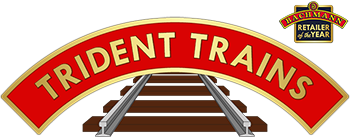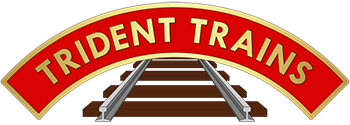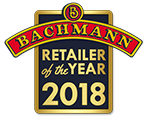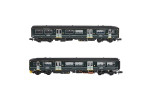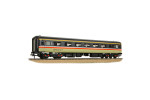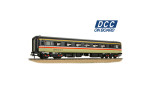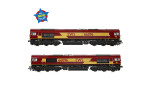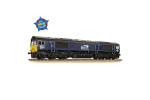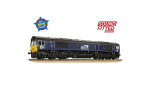Search results
 371-337
371-337Class 150/2 2-Car DMU 150232 GWR Green (FirstGroup)
he Class 150 Diesel Multiple Unit (DMU) is an enduring design, first introduced in 1984 much of the fleet remains in service today with operators including GWR FirstGroup. The striking green livery of GWR adorns the Graham Farish Class 150 DMU for the first time and we’ve selected 150/2 No. 150232 as the subject for this sublime N Scale model. The 150/2 sub-class is characterised by the gangway doors fitted to the cab ends, allowing two or more units to work in multiple whilst allowing access from one unit to another.
 371-337SF
371-337SFClass 150/2 2-Car DMU 150232 GWR Green (FirstGroup) With DCC Sound Fitted
he Class 150 Diesel Multiple Unit (DMU) is an enduring design, first introduced in 1984 much of the fleet remains in service today with operators including GWR FirstGroup. The striking green livery of GWR adorns the Graham Farish Class 150 DMU for the first time and we’ve selected 150/2 No. 150232 as the subject for this sublime N Scale model which comes complete with SOUND FITTED. The 150/2 sub-class is characterised by the gangway doors fitted to the cab ends, allowing two or more units to work in multiple whilst allowing access from one unit to another.
Constructed from a highly detailed bodyshell which is adorned with separate components like the cab front handrails, gangway connectors and exhaust, the Graham Farish model replicates the Class 150/2 faithfully. The chassis boasts a suite of parts to depict the engine, drive train, electrical gear and auxiliary equipment, while inside the model, passenger seating is included along with cab detail. The livery application, using authentic colours and accurate typefaces and logos just enhances the model’s good looks, while the powerful and smooth drive mechanism and pre-fitted DCC decoders in this SOUND FITTED model makes the Class 150 DMU the perfect addition to any modern N scale collection.
 39-653A
39-653ABR Mk2F FO First Open BR InterCity (Swallow)
 39-653ADC
39-653ADCBR Mk2F FO First Open BR InterCity (Swallow) DCC On Board
 39-725ADC
39-725ADCBR Mk2F DBSO Driving Brake Second Open BR Blue & Grey (Inter-City) DCC On Board
 50-000
50-000Class 66/0 66015 EWS
The Class 66 Diesel Locomotive revolutionised the British rail freight landscape when the first examples arrived in 1998, and more than a quarter of a century later, the type remains at the forefront of freight operations the length and breadth of the country. Now, we are delighted to present the all-new Bachmann Branchline OO Scale Class 66 which has been designed from the rails up, capturing this modern icon like never before.
 50-000A
50-000AClass 66/0 66096 EWS
The Class 66 Diesel Locomotive revolutionised the British rail freight landscape when the first examples arrived in 1998, and more than a quarter of a century later, the type remains at the forefront of freight operations the length and breadth of the country. Now, we are delighted to present the all-new Bachmann Branchline OO Scale Class 66 which has been designed from the rails up, capturing this modern icon like never before.
 50-000SFX
50-000SFXClass 66/0 66015 EWS With DCC Sound Deluxe
When it comes to technology, the specification doesn’t get any better than this SOUND FITTED DELUXE Class 66 which includes a full lighting suite with directional lights that can be switched between day and night modes, stabling mode, cab lights and machine room lights. The pre-fitted ESU Loksound V5DCC Sound Decoder plays authentic sounds through the Dual Fitted XL speaker system, and operational interruptions – like sound cut outs, stalling and light flicker – are a thing of the past thanks to our Bach-Up Stay Alive System. The Auto-Release Couplings fitted at either end of this Class 66 are the icing on the cake, providing hands-free, remote uncoupling, all automated and controlled by the press of a button.
 50-009
50-009Class 66/3 66304 DRS Compass (Small Logo)
The Class 66 Diesel Locomotive revolutionised the British rail freight landscape when the first examples arrived in 1998, and more than a quarter of a century later, the type remains at the forefront of freight operations the length and breadth of the country. Now, we are delighted to present the all-new Bachmann Branchline OO Scale Class 66 which has been designed from the rails up, capturing this modern icon like never before.
 50-009SFX
50-009SFXClass 66/3 66304 DRS Compass (Small Logo) With DCC Sound Deluxe
When it comes to technology, the specification doesn’t get any better than this SOUND FITTED DELUXE Class 66 which includes a full lighting suite with directional lights that can be switched between day and night modes, stabling mode, cab lights and machine room lights. The pre-fitted ESU Loksound V5DCC Sound Decoder plays authentic sounds through the Dual Fitted XL speaker system, and operational interruptions – like sound cut outs, stalling and light flicker – are a thing of the past thanks to our Bach-Up Stay Alive System. The Auto-Release Couplings fitted at either end of this Class 66 are the icing on the cake, providing hands-free, remote uncoupling, all automated and controlled by the press of a button.
Prev | Next
